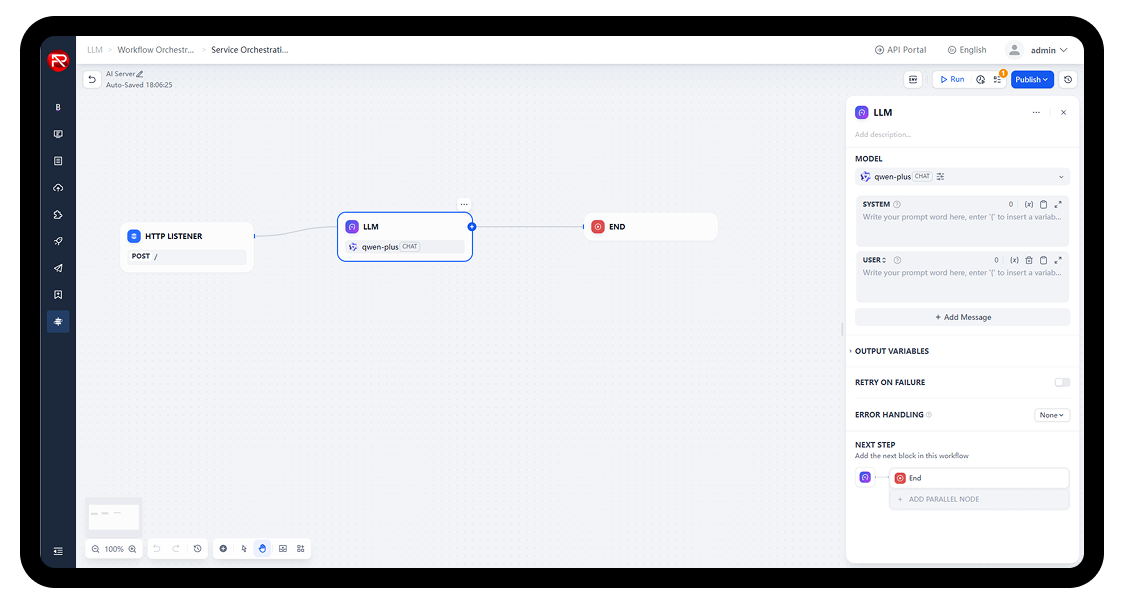AI Service Orchestration
Paraview AI Service Orchestration provides a smart and context-aware engine that adapts and evolves with your business.

Key Functions
Traditional Orchestration Components
Provides robust traditional orchestration modules supporting multiple integration protocols; supports HTTP, WebService, gRPC, message queues, scheduled tasks, file interfaces, and database operations. It enables reliable data transformation and stable connectivity, and automates end-to-end business processes.
Logic Control Components
Flexible logic control features allow precise modeling of complex workflows with dynamic conditional branching, data splitting and aggregation, and built-in exception handling that reroutes failed processes to compensation paths. The system supports both synchronous and asynchronous execution strategies.
Large Language Model (LLM) Intelligent Nodes
LLM capabilities are natively embedded as orchestratable nodes, enabling intelligent process automation and semantic enhancement for enterprises through Natural Language Processing and Understanding, Content Creation and Enhancement, AI-generated Scripting and LLM Version Management.
Runtime Governance Capabilities
The platform offers comprehensive runtime governance to enhance visibility and operational control. Features include version management with rollback and staged scheduling, visual debugging environment, and logs of execution traces and data changes for issue resolution and compliance auditing.
Traditional Orchestration Components
Provides robust traditional orchestration modules supporting multiple integration protocols; supports HTTP, WebService, gRPC, message queues, scheduled tasks, file interfaces, and database operations. It enables reliable data transformation and stable connectivity, and automates end-to-end business processes.
Logic Control Components
Flexible logic control features allow precise modeling of complex workflows with dynamic conditional branching, data splitting and aggregation, and built-in exception handling that reroutes failed processes to compensation paths. The system supports both synchronous and asynchronous execution strategies.
Large Language Model (LLM) Intelligent Nodes
LLM capabilities are natively embedded as orchestratable nodes, enabling intelligent process automation and semantic enhancement for enterprises through Natural Language Processing and Understanding, Content Creation and Enhancement, AI-generated Scripting and LLM Version Management.
Runtime Governance Capabilities
The platform offers comprehensive runtime governance to enhance visibility and operational control. Features include version management with rollback and staged scheduling, visual debugging environment, and logs of execution traces and data changes for issue resolution and compliance auditing.
Traditional Orchestration Components
Provides robust traditional orchestration modules supporting multiple integration protocols; supports HTTP, WebService, gRPC, message queues, scheduled tasks, file interfaces, and database operations. It enables reliable data transformation and stable connectivity, and automates end-to-end business processes.
Logic Control Components
Flexible logic control features allow precise modeling of complex workflows with dynamic conditional branching, data splitting and aggregation, and built-in exception handling that reroutes failed processes to compensation paths. The system supports both synchronous and asynchronous execution strategies.
Large Language Model (LLM) Intelligent Nodes
LLM capabilities are natively embedded as orchestratable nodes, enabling intelligent process automation and semantic enhancement for enterprises through Natural Language Processing and Understanding, Content Creation and Enhancement, AI-generated Scripting and LLM Version Management.
Runtime Governance Capabilities
The platform offers comprehensive runtime governance to enhance visibility and operational control. Features include version management with rollback and staged scheduling, visual debugging environment, and logs of execution traces and data changes for issue resolution and compliance auditing.
Product Technology Features
A visual drag-and-drop canvas supports major protocols (HTTP, MQ, files, scheduling, databases) and includes common logic operations like conditional branching, aggregation, and exception handling, enabling fast and efficient construction of complex workflows.

AI nodes are embedded natively in workflows to provide intelligent decision-making, content generation, and exception handling, transforming AI into a core part of enterprise automation.

Built-in version management, debugging tools, detailed logs, and auditing ensure flexible workflow updates, full execution visibility, and compliance with regulatory standards.


Use Cases
Use Cases
Intelligent Customer Service
Leveraging LLMs integrated with service orchestration, this comprehensive intelligent customer service system enables natural language understanding, automated workflow execution, and decision-making capabilities. AI nodes accurately interpret user intents and route requests through appropriate service processes, facilitating seamless end-to-end handling of complex business operations.
Text Generation with Semantic Consistency
AI nodes embedded within content workflows support automated generation, refinement, translation, and summarization of text across diverse use cases such as documentation, marketing collateral, and product information. Utilizing prompt templates and vector-based semantic enhancement ensures consistent output aligned with organizational knowledge bases, delivering high-quality and compliant content.
Knowledge-Driven Intelligent Applications
By integrating enterprise knowledge repositories with embedding technology, the platform facilitates vector-based semantic search and large model capabilities through secure service orchestration. This empowers intelligent question answering, semantic relevance matching, and context-aware content retrieval, improving the accuracy and effectiveness of search, recommendation, and knowledge management systems.
Multi-Model Hybrid Governance
Supporting seamless integration with leading commercial and private LLMs, combined with federated routing and multi-criteria scheduling, the platform dynamically selects the most appropriate model based on factors such as business requirements, latency, and content sensitivity. This approach optimizes cost, performance, and regulatory compliance while mitigating risks related to vendor lock-in.
Business Benefits
Improved Service Integration Efficiency
Enable rapid development of cross-system and cross-model intelligent service workflows, streamlining the development process, shortening time-to-market, and meeting the demand for agile business responsiveness.
Reduced Service Development Costs
Support low-code configuration and version management, minimizing redundant development and manual integration efforts, lowering the cost of building and maintaining AI-driven services while improving overall resource efficiency.
Enhanced User Experience
Understand user intent more accurately and provide more intuitive interactions—significantly improving user experience across scenarios such as customer support, content access, and intelligent search and recommendation.
Related Case Studies
Ready to Embrace a Safe and Efficient Digital World?
Contact us and Let’s discuss how Paraview can secure your identity and API assets.